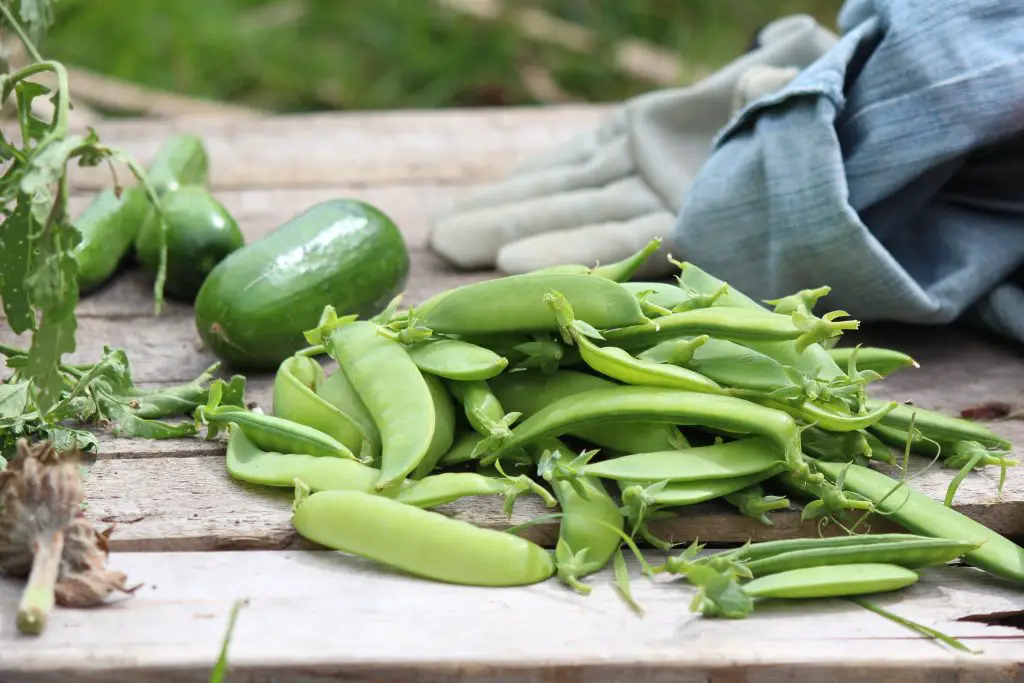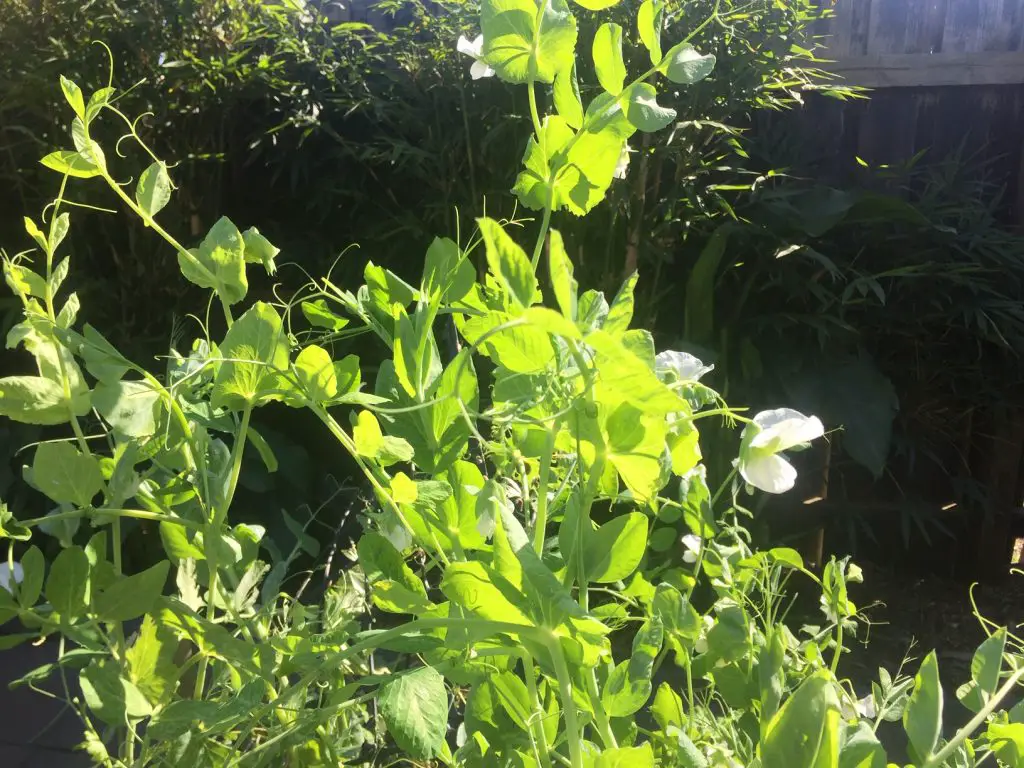How Many Snow Peas Does A Plant Produce? Snow Peas are one of the easiest plants to grow in your yard at home. They don’t take up a lot of space and they produce prolifically once they get going. However, to ensure that you have enough snow peas it is important to understand how many Snow Peas they produce per plant.
Snow Pea plants will produce approximately 150 g (5.3 oz) per plant which equates to around 45 to 50 pods per plant. The plants will typically start to produce 2 months after sowing and they can be harvested for a period of 4 to 6 weeks before the plant dies back.
To ensure that there is a plentiful supply of Snow Peas it is recommended that between 15 to 20 plants per person be planted in your garden. That volume of plants will produce between 2.5 and 3.0 kg (5 to 6 lbs) of pods and will require 0.5 sqm (4 to 5 sqft) of space.
What Is The Best Time To Plant Snow Peas?
Snow Peas are a cool-season vegetable that prefers to be grown in the cooler parts of the growing season, either in Spring or Autumn. They are a crop that is best sown in early Spring or late Summer to early Autumn. Due to the relatively short cropping window, which is usually only 4 to 6 weeks, it is best to sow successional batches to extend the period of cropping.
In my own garden, I typically sow Snow Peas 4 times in the growing season to maximize the harvest period. The first sowing of the season is typically done in early Spring undercover. The second sowing is done a few weeks later in Mid Spring. The first Autumn Sowing is done in late Summer and then there is typically a sowing done in early to mid-Autumn.

The last Autumn Sowing needs to be done early enough to allow the plants to become established before the cold weather arrives. The plants can then can sit all winter ready for an early spring harvest. The ability to be able to do this is limited by how cold the winters get in your location.
What Is The Minimum Temperature Snow Peas Can Tolerate?
Snow Peas are a relatively hardy plant that can be grown in Winter in many locations. Typically, Snow Peas will be unaffected at temperatures above 28°F (-2°C). At temperatures between 20°F and 28°F (-2°C to -6°C) Snow Peas will survive but will suffer some damage. However, if the Snow Peas are protected with row cover or have been insulated by a blanket of snow the Snow Peas can survive temperatures as low as 10°F (-12°C) with limited damage.
There are many different types of row covers that can be purchased however, the one we recommend is Growsun Garden Tunnel Plant Cover. The main reason for this is that it is relatively tall which allows taller plants to be protected. Secondly, it has hoops that can be anchored deeply into the ground to resist high winds. Additionally, it has clips and staples ensuring that the cover is secure.

How To Grow Snow Peas
Snow Peas can be grown easily from seed by planting directly into the soil, however, my personal preference is to sow into seed trays. The reason for this is you can start the seeds earlier in the season by storing the seed trays inside. Secondly, it is easier to protect young seedlings from attack from slugs and snails. Lastly, it reduces the time that the crop spends in the ground which allows the space to be utilized for other crops.
When sowing the seeds it is best to plant two seeds per cell to ensure all the cells have at least one plant in them. When calculating the number of seeds to sow it is best to plant 25% to 50% more than you need as this will ensure you produce enough seedlings and have plenty to spare just in case any are destroyed by pests.
If you live in the US and need to buy seeds we recommend Seeds For Generations or St Clare Seeds. In the UK we recommend that you visiting Thompson and Morgan’s website as they have a broad range of different varieties to choose from.
Snow Pea seedlings will emerge relatively quickly and typically will take 4 weeks to reach sufficient size to allow them to be planted outside. However, if space is not yet available in your garden or the weather is not yet favorable the time in the seed tray can be extended out to 6 weeks.
When it is time to plant the seedlings select a location within your garden that receives at least 6 to 8 hours of sun per day. Before planting out the seedlings it is best to install a support structure first to avoid disturbing the roots later. A trellis with a range of points that the plant can cling to is best, single stakes are not a good option.
Additionally, it is important to prepare the soil for the plants before planting. Snow Peas prefer a moist rich soil with plenty of organic matter that is slightly acidic if possible. This can be achieved by adding plenty of compost to the soil.
Once the support structure is in place plant the seedlings at the base of the structure 7 to 10 cm (3 to 4 inches) apart. If you have 2 plants in a cell it is not necessary to separate them.

Once established the Snow Peas will begin to climb the structure using their tendrils to cling to it. Despite this, it will still be necessary to tie the Snow Peas into the structure as the plants can become quite unwieldy if allowed to grow unchecked. The height that the Snow Peas reach is dependent upon variety, most varieties reach 90 to 120cm (3 to 4 ft) however, there are taller varieties that can reach up to 2m (6 to 7 ft) tall.
Harvesting Snow Peas
Once the stems have developed the plant will begin to produce a mass of flowers from which the pods begin to emerge. Snow Pea pods are best picked when they are 7 to 10 cm (3 to 4 inches) long and the peas in the pod are just beginning to develop. However, if you are a little impatient you can harvest them when they are smaller.
When removing the pods from the plant be careful not to damage the stem by pulling the pods. It is best to use secateurs to move the pods to avoid damage. To maximize the yield plants should be harvested every 2 to 3 days as this will encourage the plant to continue to produce flowers for an extended period of time.
Storing Snow Peas
Snow Peas are best picked and eaten fresh, however, it is inevitable that you will have a glut of Snow Peas at some stage during the season. And while it is possible to store them in a fridge for a short period of time it is likely that long-term storage will be required.
For short-term storage, Snow Peas are ideally stored in a cool and moist place with a temperature of approximately 4°C (40°F). To maintain the moisture they can be stored in a plastic zip-lock bag with a few drops of water. Under these conditions, the Snow Peas can be stored for approximately 1 to 2 weeks.
For long-term storage Snow Peas can be frozen, however, it is necessary to blanch them before freezing. The reason for this is that it will halt enzyme activity within the Snow Peas, preventing a loss of texture and color. If you are unfamiliar with how to blanch vegetables, the steps are provided below;
- Step 1: Wash the Snow Peas and Remove the Ends.
- Step 2: Blanch the Snow Peas by bringing a large pot of water to boil. Fill a large bowl with ice water, just prior to starting the blanching process. Once the pot is boiling, put the Snow Peas into the water. Cook for 1 minute, then remove from the pot and immediately plunge the Snow Peas into the ice water to cool, for around the same amount of time as the blanching, and then drain thoroughly.
- Step 3: Prepare the Snow Peas for Freezing, Then Freeze. Pack all of your blanched Snow Peas into plastic bags, or suitable containers. Ensure each bag or container is labeled with dates.
